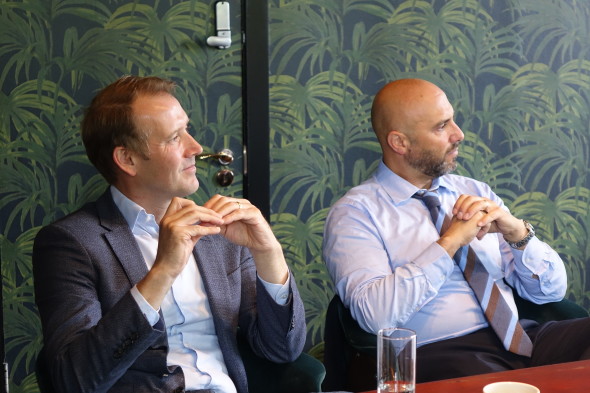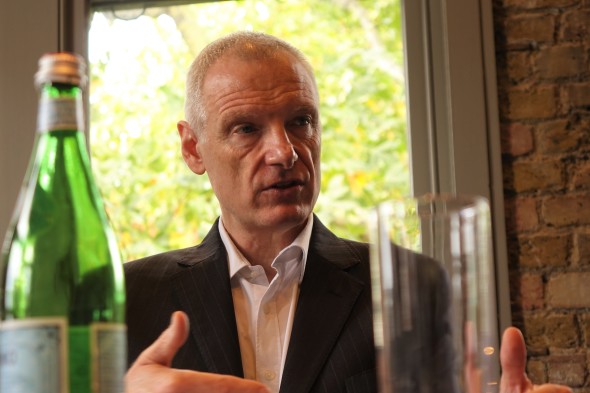
In a fast moving and dynamic market Contact Centre solutions and how to sell them are being impacted by an array of factors that include Digital Transformation, social media and artificial intelligence. Comms Business Magazine reports from a round table discussion with channel players on the implications of these dynamics for the resellers.
Organisations today face a number of imperatives. Digital disruption is affecting every business sector and causing firms to revise their strategies by adopting a customer led ethos. Today, we are in a time of ‘change or be changed’ and at the heart of those changes being adopted, in order to resist potential disruption, is a need to achieve customer service excellence.
For business, this means not only embracing a customer centric focus but also having the right technology based applications to both understand and effectively interact with all the customer cohorts they hope to supply.
This is a model that Gary Bennett, VP Sales (EMEA) at Enghouse, fully endorses.
“Over the last three years we have witnessed a sea-change in our business. From typical deployments in the 30 to 50 seat sector, we are now seeing ‘fully-loaded’ 150-seat applications being regularly implemented. Enghouse, and our partners, have moved significantly up the stack; our voice is more relevant and our opinions are sought.
Change is always there; it’s constant and both we and our partners deal with it. But frequently we find that users are reluctant, even frightened, to undertake change. Partners such as we have here, ScanSource, GCI, 5i and 4net have seen the changing dynamic and have themselves responded with their own transformations.
We are at an inflection point and see exciting times ahead with both opportunities and threats brought about by the cloud, technology and Microsoft. Who would have thought three years ago that customer contact centres would become so strategic for business?
There are challenges for businesses trying to digitise a connected journey for their customers and many are struggling to implement their digital transformations.”
Steve McLaughlin, Technical Business Specialist at distributor ScanSource believes that there are pain points throughout the channel and smaller resellers are in general steering clear of Microsoft Skype based Digital Transformations.
“Since ScanSource became a distributor for Enghouse it has been clear there’s a lot of knowledge and skills we need to bring these resellers on board with these solutions.”
“There’s a big education piece here.” Says Jenny Bratherton, Director of Voice Sales at 5i. “Such as ‘how do you deploy `Skype for Business’ in the first instance, how do you integrate the Enghouse contact centre? Resellers are great at relationships and finding sales opportunities but don’t necessarily have the right skill sets. This is where we get involved offering support throughout the sales process.
Andy Patrick, Head of Client Services at 4net Technologies, has seen a big shift in technologies in the market place and the options available.
“Now we have more choices when it comes to these applications. Users like to have one supplier for their services which why it is so important for us as a reseller to be able to provide what they want – a competent single supplier.”
Dominic Hughes, Director of Strategic Channel Partner Accounts at service provider GCI, notes that user expectations change over time. “Today Apple has set a standard for contact and service that users are demanding and expecting from their suppliers.”
Automation
When it comes to customer service solutions, Artificial Intelligence (AI) and process automation are increasingly rising up the Digital Transformation agenda as Gary Bennett at Enghouse acknowledges.
“The last thing you want to do is spend time in a call queue and today there is a far greater willingness for customers to engage in self-service. For the Contact Centre, this is a ‘cascading’ feature where AI Bots and Chat come in to play. However, all the ‘easy’ tasks are being automated leaving just the ‘ugly’ stuff for the Contact Centre to handle.
These awkward or more difficult calls need handling by agents with higher skill levels so being able to locate such an agent to quickly take the call is very important. This is where Skype for Business and its ability to provide indication of presence is driving the market. Microsoft has excelled in making life easy for a generation and now, through their accreditation schemes, there is a natural gravitational pull towards Skype.”
According to Gary Bennett, Skype continues to develop. “It now provides robust services for business including voice and offers huge savings for users and has a road map that includes Teams. Pieces of the puzzle are falling in to place with Skype getting stronger and stronger as a proposition.
Kids today and those coming through to the workplace are ‘super-connected’ and do not understand when they call a Contact Centre why they are not immediately identified and recognised. An issue could be that consumers outspend businesses by ten to one when it comes to technology and businesses are playing catch-up. However, for many organisations this is the equivalent of trying to change a jet engine in mid-flight.”
4net’s Andy Patrick agrees, “Resellers such as ourselves have had to adapt beyond our legacy suppliers, and develop our Microsoft services offerings.”
Likewise, GCI’s Dominic Hughes says this is true for many resellers. “The services wrap that you are able to provide with Microsoft will replace other income streams.”
And what could that trend lead to? Well Gary Bennett believes that the next disruptive process in the channel could be resellers buying in Microsoft application layering skills; either by working with partners, hiring staff or acquisitions.
 Dominic Hughes, Strategic Sales management – GCI and
Dominic Hughes, Strategic Sales management – GCI andAndy Patrick, Head of Client Services at 4net Technologies
Social Media
Today, social media is having a huge influence in how customers select their suppliers of goods and services. As Steve McLaughlin at ScanSource notes, “Users are posting on social media sites to get responses from organisations. They like the medium as they can dictate the pace of contact.”
However, there’s a higher skill set at play here according to Gary Bennett. “If a firm makes poor responses on Facebook the whole world can see the lack of service, influencing their own buying decisions. It’s important however that customers get a good experience which ever channel they choose to use. Making a voice call to a contact centre should produce just as good a result and not be considered as being the last resort.
Andy Patrick believes that typically, the big utility firms are the benchmark for driving user experience and that the driver for consumers is all about saving time. He notes, “Email is still the most popular channel for communication, it also leaves a time stamp on the contact trail if any issues arise further down the line.”
The room is nodding in agreement. Jenny Bratherton adds, “Many users turn to social media to get resolutions when they reach the end of their tether.” Richard Snow, Consultant at Ventana Research, makes a good point here by saying there is a lot of confusion between onmi-channel and multi-channel contact centre applications.
“If there is no transfer of contact information say between email and chat then that is multi-channel and the caller will have to start the ‘call’ again at the beginning. If they want to be omni-channel systems need to talk to each other to create a holistic view of the customer journey.”
Data Analytics
Successful Digital Transformation deployments should result in the exposure of relevant user information and data and Gary Bennett sees this as being the Holy Grail for business where success lies in getting advocates for your products and services.
“We are all time poor today but effective business analytics – using the data you have gathered, and realising the value it holds is now crucial.
Customers value their time and like solutions that provide results with the least effort. Therefore, firms should look closely at the channels they use for different cohorts, the journeys they take and optimise their responses and resources accordingly.”
Andy Patrick makes the point that these journeys are becoming increasingly important and firms need to use analytics to better understand their customers by bridging that knowledge gap.
“What kind or type of customer are we dealing with, who can best answer the questions they have and what technology do we need to deploy to effectively manage each workflow those journeys throw up?”
 Gary Bennett, Sales Director UK & I Channels & Partners – Enghouse
Gary Bennett, Sales Director UK & I Channels & Partners – EnghouseHow should resellers react?
Gary Bennett sees two solutions for these resellers. “Firstly, becoming managed services providers. Users need to have service reliability and consistently – keeping solutions working and then extending that service. Secondly, through white labelling technical and service elements and bundling for differentiation.”
“That works,” says Jenny Bratherton. “Resellers white label our services on the monthly, per user model that customers want today. It helps resellers cross that chasm.”
“Generally resellers provide solutions in siloes”, notes Gary Bennett. “They need to consider working with other resellers to provide the complete user solutions.”
That’s a problem according to Steve McLaughlin. “We are not aware of a single Avaya reseller that has built a successful Microsoft business without buying in those skills. For most resellers, it represents a total change in the way that they work – sales, technical, workflow processes and a shift from Capex to Opex – it’s all different. It’s like starting a new business.”
Gary Bennett advises that undertaking proof of concept mitigates these unknowns and most problems ahead of implementations.
“But this highlights a re-occurring theme – a gap in confidence and understanding around the Microsoft commercial model. There is no money to be made in selling licenses, it has to be made in the services wrap.”
Ed says...
Successful Digital Transformations are made up of many components where having the right technology can form a foundation on which to build a customer led company ethos that sees the end of working in silos and embracing real time collaboration. Using business analytics to determine what users actually think about your existing products and services is a vital component in that mix and enables firms to develop new products that users want and, significantly, bring them to market faster than their competitors.
